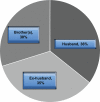Screening for domestic violence in Jordan: validation of an Arabic version of a domestic violence against women questionnaire
- PMID: 21445377
- PMCID: PMC3061851
- DOI: 10.2147/IJWH.S17135
Screening for domestic violence in Jordan: validation of an Arabic version of a domestic violence against women questionnaire
Abstract
Objectives: Abuse against women causes a great deal of suffering for the victims and is a major public health problem. Measuring lifetime abuse is a complicated task; the various methods that are used to measure abuse can cause wide variations in the reported occurrences of abuse. Furthermore, the estimated prevalence of abuse also depends on how abuse is culturally defined. Researchers currently lack a validated Arabic language instrument that is also culturally tailored to Arab and Middle Eastern populations. Therefore, it is important to develop and evaluate psychometric properties of an Arabic language version of the newly developed NorVold Domestic Abuse Questionnaire (NORAQ).
Design and methods: The five core elements of the NORAQ (emotional abuse, physical abuse, sexual abuse, current suffering of the abuse, and communication of the history of abuse to the general practitioner) were translated into Arabic, translated back into English, and pilot tested to ensure cultural sensitivity and appropriateness for adult women in the Eastern Mediterranean region. Participants were recruited from the Jordanian Ministry of Health-Maternal and Child Health Care Centers in two large cities in Jordan.
Results: A self administered NORAQ was completed by 175 women who had attended the centers. The order of factors was almost identical to the original English and Swedish languages questionnaire constructs. The forced 3-factor solution explained 64.25% of the variance in the measure. The alpha reliability coefficients were 0.75 for the total scale and ranged from 0.75 to 0.77 for the subscales. In terms of the prevalence of lifetime abuse, 39% of women reported emotional abuse, 30% physical abuse, and 6% sexual abuse.
Conclusion: The Arabic version of the NORAQ has demonstrated initial reliability and validity. It is a cost-effective means for screening incidence and prevalence of lifetime domestic abuse against women in Jordan, and it may be applicable to other Middle East countries.
Keywords: Jordan; Middle East; domestic violence; instrumentation.
Figures
Similar articles
-
Reflections on the Translation Into Arabic and Validation Process of the NorAQ Abuse Questionnaire.J Interpers Violence. 2019 Feb;34(3):585-598. doi: 10.1177/0886260516644595. Epub 2016 Apr 18. J Interpers Violence. 2019. PMID: 27094009
-
NorVold Abuse Questionnaire for men (m-NorAQ): validation of new measures of emotional, physical, and sexual abuse and abuse in health care in male patients.Gend Med. 2011 Apr;8(2):69-79. doi: 10.1016/j.genm.2011.03.001. Gend Med. 2011. PMID: 21536226
-
Prevalence and risk factors of domestic violence in women attending the National Guard Primary Health Care Centers in the Western Region, Saudi Arabia, 2018.BMC Public Health. 2020 Feb 17;20(1):239. doi: 10.1186/s12889-020-8156-4. BMC Public Health. 2020. PMID: 32066422 Free PMC article.
-
Sequelae of abuse. Health effects of childhood sexual abuse, domestic battering, and rape.J Nurse Midwifery. 1996 Nov-Dec;41(6):442-56. doi: 10.1016/s0091-2182(96)80012-7. J Nurse Midwifery. 1996. PMID: 8990716 Review.
-
Prevalence of intimate partner violence against women in the Arab world: a systematic review.BMC Int Health Hum Rights. 2019 Oct 22;19(1):29. doi: 10.1186/s12914-019-0215-5. BMC Int Health Hum Rights. 2019. PMID: 31640716 Free PMC article.
Cited by
-
Exploring Jordanian women's resistance strategies to domestic violence: A scoping review.Front Sociol. 2022 Nov 10;7:1026408. doi: 10.3389/fsoc.2022.1026408. eCollection 2022. Front Sociol. 2022. PMID: 36439076 Free PMC article.
-
Development and validation of the nurses sexual harassment scale in Iran.BMC Nurs. 2024 Feb 8;23(1):107. doi: 10.1186/s12912-024-01759-6. BMC Nurs. 2024. PMID: 38326844 Free PMC article.
-
Well-Being and Associated Factors among Women in the Gender-Segregated Country.Int J Environ Res Public Health. 2017 Dec 14;14(12):1573. doi: 10.3390/ijerph14121573. Int J Environ Res Public Health. 2017. PMID: 29240670 Free PMC article.
-
Violence and depression among pregnant women in Egypt.BMC Pregnancy Childbirth. 2021 Jul 12;21(1):502. doi: 10.1186/s12884-021-03932-0. BMC Pregnancy Childbirth. 2021. PMID: 34247570 Free PMC article.
-
Psychometric Properties of a Screening Instrument for Domestic Violence in a Sample of Iranian Women.Nurs Midwifery Stud. 2016 Mar 5;5(1):e27763. doi: 10.17795/nmsjournal27763. eCollection 2016 Mar. Nurs Midwifery Stud. 2016. PMID: 27331052 Free PMC article.
References
-
- United Nations Development Fund for Women. New York: 2000. Domestic violence against women and girls report.
-
- Division for the Advancement of Women; Committee on the Elimination of Discrimination against Women. General recommendation no 19: Violence against women. 1992. 2002. Available from: http://www.un.org/womenwatch/daw/cedaw/recommendations/recomm.htm#recom19. Accessed 14 Feb 2011.
-
- World Health Organization. 1996. (Document FRH/WHD/96.27). Violence against women. Available from: http://whqlibdoc.who.int/hq/1996/FRH_WHD_96.27.pdf. Accessed 14 Feb 2011.
-
- Berry DB. The Domestic Violence Sourcebook. Los Angeles, CA: Lowell House; 1998.
-
- Heise L, Garcia-Moreno C. Intimate partner violence. In: Krug EG, Dahlberg LL, Mercy JA, et al., editors. World Report on Violence and Health. Geneva, Switzerland: World Health Organization; 2002.
LinkOut - more resources
Full Text Sources




